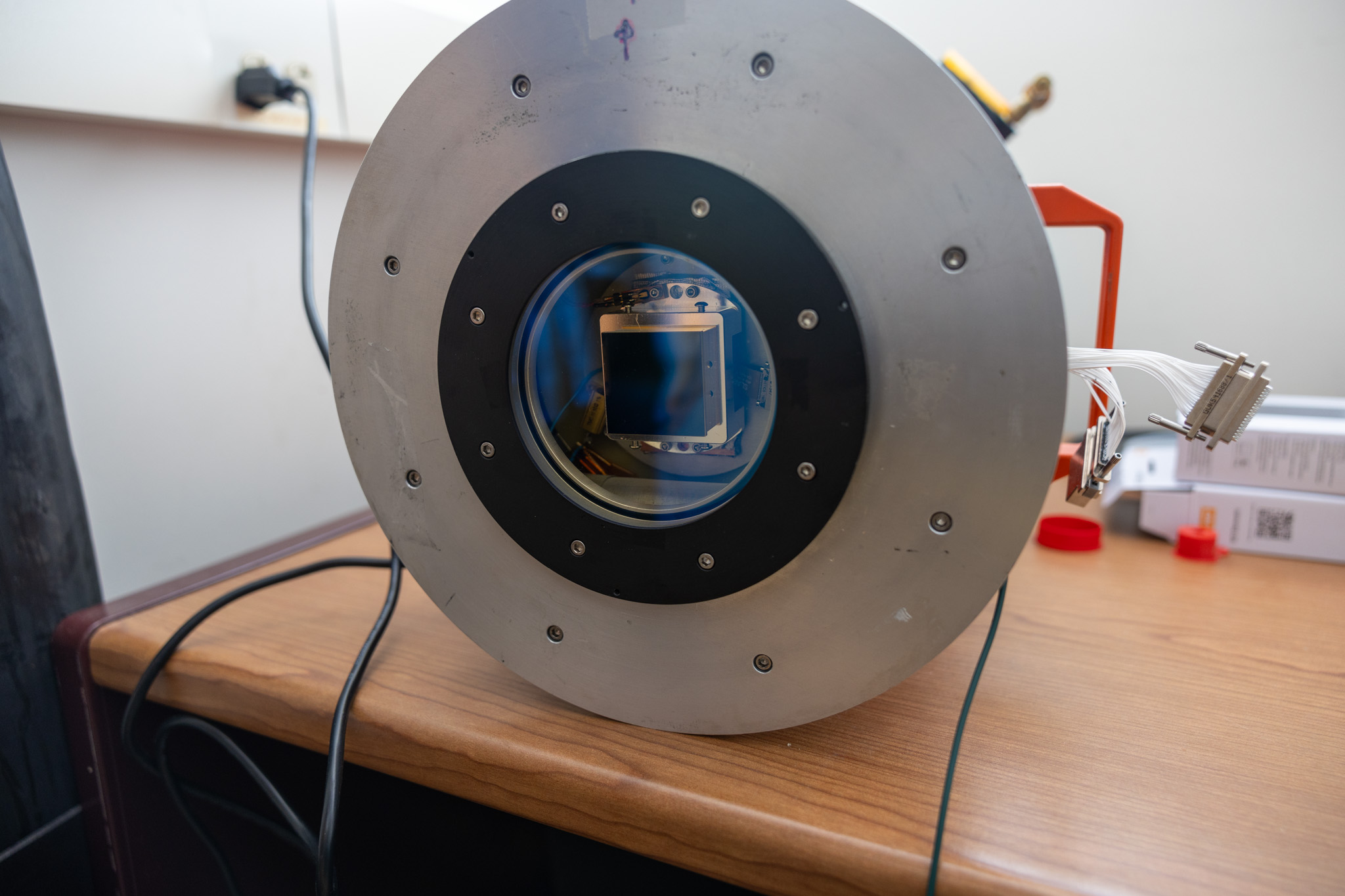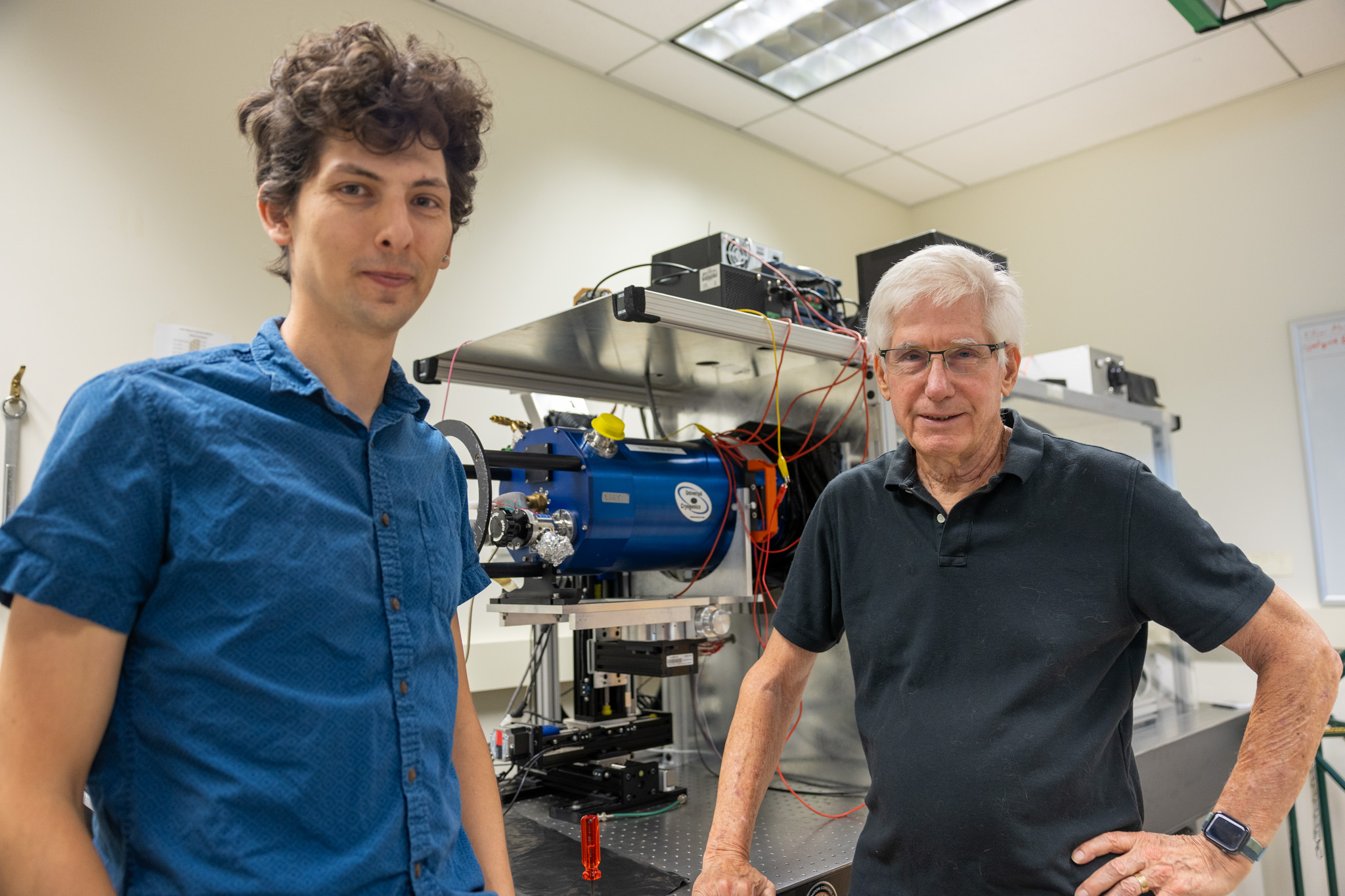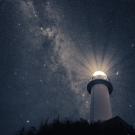
Origins of the Rubin Observatory with Chief Scientist Tony Tyson
In a dark, light-tight room on the fifth floor of the UC Davis Physics Building, researchers recreate the night sky. But the simulated sky isn’t projected onto a wall or ceiling. Instead, a large, tube-like device, housed in a transparent cage, uses a reticle mask, also known as a photomask, to achieve the simulation. Wires crisscross the optical simulator. Liquid nitrogen cools it when it’s in use.
The researchers running the instrument aren’t interested in recreating pristine night sky conditions. They want to recreate noisy, realistic conditions. After all, the modern night sky is replete with human-made objects. Thousands of satellites orbit the planet, introducing observational hurdles to astronomers and astrophysicists on the ground.
Overcoming this challenge is especially important for the Vera C. Rubin Observatory, a groundbreaking facility currently under construction atop the mountain Cerro Pachón in Chile. Equipped with the largest digital camera ever built, the observatory will continuously scan the night sky to create “an ultra-wide, ultra-high-definition, time-lapse record — the largest astronomical movie of all time,” as noted on the observatory’s website. The project is supported by the National Science Foundation and the Department of Energy.
The observatory’s advanced instrumentation will allow researchers to sift through the noise and probe the faintest of signals in the cosmos, allowing them to untangle the mysteries of dark matter and dark energy and map the Milky Way, among other research aims.
Tony Tyson, a Distinguished Research Professor in the Department of Physics and Astronomy at UC Davis, is the chief scientist of the observatory. For nearly three decades, Tyson has helped shepherd the ideation of and technology behind the Rubin Observatory. In his simulation lab at UC Davis, he and colleagues are refining and tweaking the underlying imaging technology employed by the observatory, with the intent to ready its cameras for the noise and interference it will encounter once it goes online later in 2025.
“I’ve been fascinated, maybe even obsessed, with the notion of digging faint signals out of the noise and doing experiments that reveal the fundamental properties of nature,” said Tyson.

From ham radio to the stars
For part of his adolescence, faint signals were all that connected Tyson to the outside world.
“I was a very sick child and in a steam tent for a year,” said Tyson, who suffered from rheumatic fever at the time. “My dad got me an old shortwave radio, and I put on headphones and dropped a wire out of the window. I could tune in the rest of the world.”
That experience with shortwave radio spurred an interest in Tyson. Transmissions, invisible to the naked eye, were all around. He just needed to find a way to tune into them. By age 12, Tyson secured a ham radio license. As he sifted through the static, he connected with others from around the world. Years later, he applied this antenna-like attention to the stars.
While working as a member of the technical staff at Bell Laboratories, where he spent decades of his professional career, Tyson started devising methods and technologies to detect faint radio and optical signals. Eventually, he stumbled upon charge-coupled devices (CCDs), a nascent, chip-based technology used to convert photons to images.

“It was a gradual evolution and I started playing with those tiny CCDs,” Tyson said. “Over a number of years, we managed to make them bigger and bigger so that you could then cover a large focal plane in a camera with these larger CCDs.”
As the technology was refined, Tyson and colleagues applied CCDs to optical astronomy. Using them, they discovered a population of extremely distant galaxies known as faint blue galaxies.
“We realized that if we’re looking at this giant forest of galaxies, some of them must be behind the others that are in the foreground,” Tyson said. “Einstein taught us that if an object has a mass between you and it, that everything behind this mass will be distorted and moved to a new place in the sky.”
Tyson realized that dark matter also influences this distortion, creating a cosmic mirage. In the 1980s, he and his colleagues harnessed this information to use weak gravitational lensing as an avenue to map dark matter.
In the 1990s, Tyson and Gary Bernstein built the Big Throughput Camera, which was outfitted with four CCDs. The camera was installed in the Victor M. Blanco Telescope in Chile. According to the Smithsonian, the camera was integral to the discovery that the expansion of the “universe is accelerating, and to the realization that there must exist a repulsive force driving the acceleration, now called dark energy.” It now resides in a Smithsonian museum in Washington, D.C.
Tyson’s work pioneering weak gravitational lensing and building the Big Throughput Camera inspired him to pursue building a telescope for the distinct purpose of studying dark matter and dark energy. In 1996, he dove into the project, becoming the founding director of what he then called the Dark Matter Telescope.
Launching the Rubin Observatory
Over the ensuing years, the Dark Matter Telescope evolved. As substantial funds were raised for its construction, name changes occurred. First, it changed to the Large Synoptic Survey Telescope.
“Synoptic means ‘the big picture,’” explained Tyson. “The telescope’s aim is to cover the whole sky rapidly many times per night. All night, 24/7, for 10 years. That’s, in some sense, a digital motion picture of the universe.”
Then on December 25, 2016, pioneering astronomer Vera C. Rubin passed away. In the 1960s, Rubin conducted experiments that solidified the notion that galaxies are held together by dark matter.
“Her observations indicated that the mass was not where the light was. By following the gas and stars in her measurements, it seemed they were embedded in some giant halo of invisible mass,” Tyson said. “If it weren’t for galaxies existing in this giant halo of mass, they would be unstable and they would fly apart.”
In honor of their friend, Tyson and colleagues renamed the project the Vera C. Rubin Observatory.
Tyson has worn many hats during the observatory’s ideation and construction. He’s raised funds from both private and public investors, fostered relationships with titans of industry to advance the mirror technology behind the observatory and set up a laboratory on the UC Davis campus to test the CCDs necessary for the observatory to meet its mission, to name just a few of his roles.

A UC Davis home for testing CCDs
With the Rubin Observatory’s first light slated for this year, the team is now barreling towards the construction finish line. In January 2025, the observatory completed a “series of full-system tests using an engineering test camera,” which “sets the stage for the last step of Rubin construction: installation of the 3200-mexapixel LSST Camera — the largest digital camera in the world,” the observatory reported in a press release.
The LSST Camera comprises 189 CCDs, weighs as much as a minivan and will capture, in a single image, an area 45 times the size of the full moon.
In the optical simulator lab at UC Davis, individual CCDs are being tested to ensure they’re up to snuff.
“We have a lab that studies and characterizes potential errors that happen in imaging with CCDs, which are the detectors used in the camera,” said Dan Polin, a graduate student in Tyson’s lab who assisted with building the camera at the SLAC National Accelerator Laboratory. “We have a pretty sophisticated apparatus.”
“Ninety percent of instrumentation is troubleshooting,” added Polin.
Postdoctoral researcher Adam Snyder is currently conducting much of the optical simulator work.
While the LSST camera dwarfs the camera setup in Tyson’s optical simulator lab, the famous adage of “big things have small beginnings” is apropos for the connections between the two.
In the lab, the team simulates various night sky conditions using reticle masks. The masks, which reimage a sky scene onto the CCD, can appear like a grid of stars, whole galaxies and even satellite trails.
After decades of meticulous testing and effort, Tyson is looking forward to the Rubin Observatory’s first light.
“It is gratifying the see all the work of our colleagues on the LSST construction project pay off,” he said. “It is those dedicated engineers and scientists who we have to thank for getting us to where we are today.”
“For me, there is increasingly something else very special,” he added. “As I look around at the young enthusiastic students attending our public meetings, I see the future. They will make discoveries of the unexpected in the LSST data. Something beyond our current understanding of the universe. That’s exciting.”
YOU MAY ALSO LIKE THESE STORIES

Andreas Albrecht Discusses Cosmic Mysteries with Brian Greene at World Science Festival
Distinguished Professor Andreas Albrecht, Department of Physics and Astronomy, recently sat down with author and physicist Brian Greene for a wide-ranging conversation about the origins of our universe.

Polarization Signals from Universe’s First Light Emphasize Hubble Tension
In a new study, UC Davis researchers, and their colleagues in the South Pole Telescope (SPT) collaboration, used observational data of this first light — collected from the SPT located at the National Science Foundation’s Amundsen-Scott South Pole Station in Antarctica — to explore the theoretical underpinnings of the standard cosmological model of the Big Bang.
